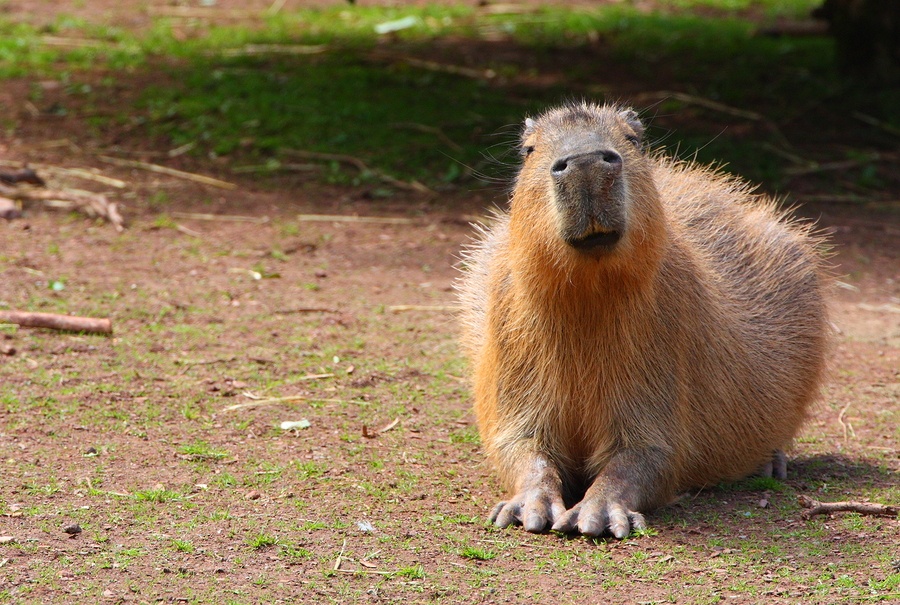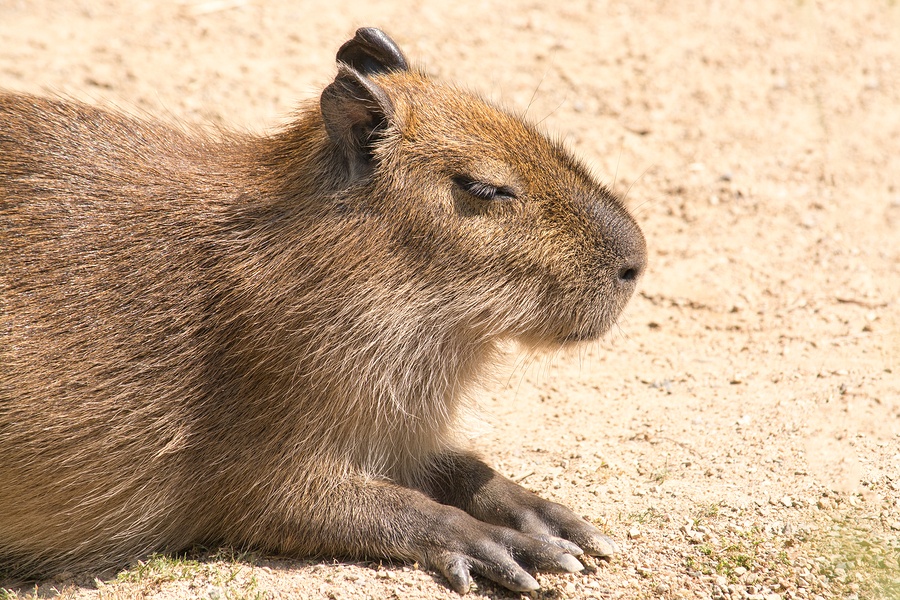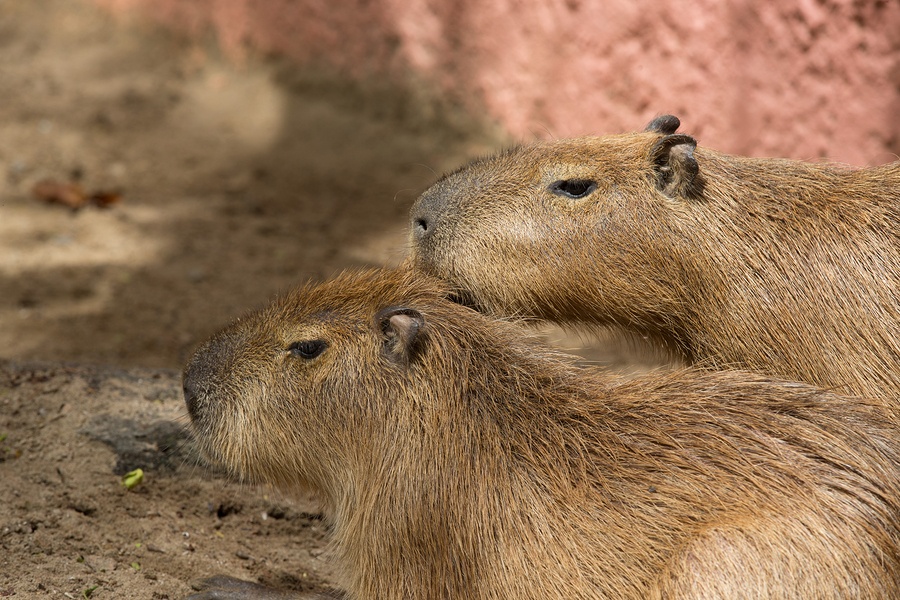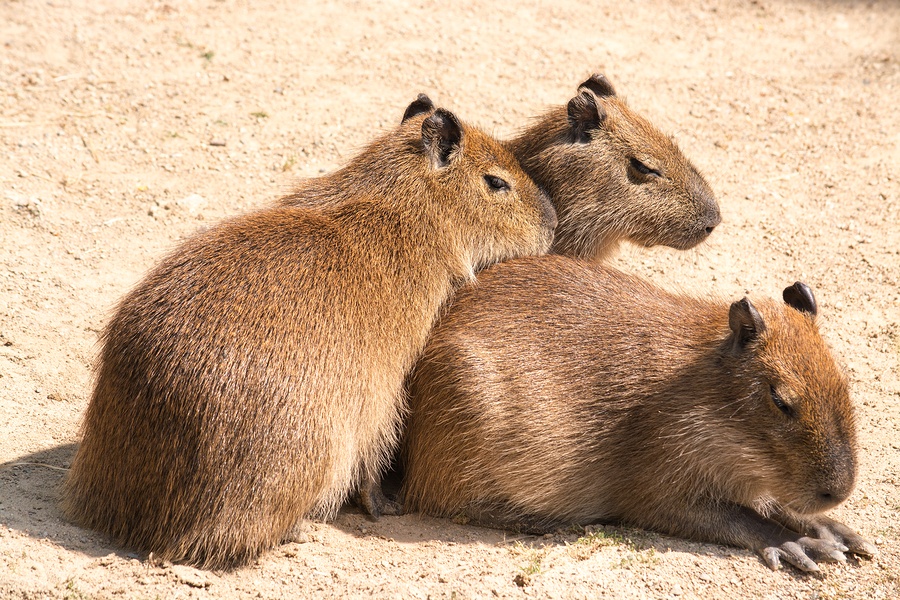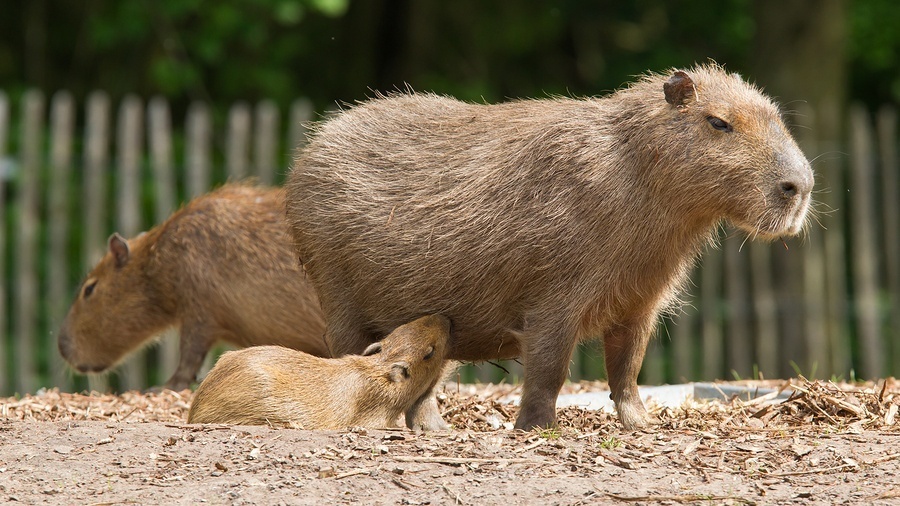Chapters
Navigate to chapter
► Chapter 1: Understanding the Capybara
► Chapter 2: Buying a Capybara
► Chapter 3: Daily Care of a Capybara
► Chapter 4: Health Care for Your Capybara
► Chapter 5: Breeding Capybaras
► Chapter 6: Frequently Asked Questions
Chapter 1: Understanding the Capybara
When you first look at a capybara, you won’t quite understand what kind of animal you’re seeing. They appear to be a cross between an overgrown guinea pig and a beaver, which is appropriate, since they are related to both animals.

The capybara is native to almost all regions of South America except Chile, and is the world’s largest rodent. They are also kin to the porcupine, mara, and more distantly to the chinchilla and agouti.
In their native habitat, the capybara is called a “water hog.” The species is not threatened, and enjoys population stability in part because they breed easily and prolifically.
Threats
Capybara are hunted for their pelts and meat. A grease derived from their skin is used in pharmaceuticals, and the hide itself makes an unusually high-quality leather.
Farmers mistakenly view the animals as competitors for prime grazing land with domesticated livestock, primarily cattle, and kill them as nuisance pests.
These pressures have not, however, affected the wide distribution of the species, and capybaras actually benefit from deforestation that creates more available grassland.
Populations of capybara living along rivers do disappear in the presence of intense human populations, but overall, the species has proven remarkably adaptable and enduring.
Native Habitat
Capybara are semi-aquatic, and prefer areas of dense forest near rivers, lakes, swamps, marshes, or ponds as well as flooded savannas.
One of their favorite pastimes is wallowing in mud, which they do when the heat rises at midday. In the afternoon and early evening they graze, then rest until midnight before continuing to feed until dawn.
Agile and swift, they can reach speeds over short distances comparable to that of a horse and seemingly turn on a,dime. Capybaras are also superb swimmers and can remain submerged for as long as five minutes.
Physical Characteristics
A capybara vaguely resembles a barrel with legs. They are heavy animals with brownish to red fur covering the upper body, yellowish hair on their bellies, and vestigial tails.
There are no color or coat variations. The hair is wiry in texture and sheds only a few coarse strands at a time. As adults, their hair is thinly dispersed, which can make them easily subject to sunburn. They have no odor.
Size and Weight
Adults reach a maximum length of 3.51-4.40 feet (107-134 cm) and are 20-25 inches (50-64 cm) tall at the withers, the highest part of the back near the neck.
Their average weight is 77-146 lbs. (35-66 kg), with some wild specimens topping out at 162 lbs. (73.5 kg). Females tend to be somewhat heavier than males.
In stature, the hind legs are a little higher than the front. There are four toes on the front feet and three on the back, all slightly webbed.
Head and Jaws
The heavy heads end in blunt muzzles with small eyes and ears located near the top of the head. Since they lack a perpendicular jaw hinge, they chew their food in a grinding side-to-side motion.
They are somewhat similar to cattle in that they will often regurgitate their food to chew it again. Capybaras are also coprophagous, eating their own feces to maintain their gut flora and to more efficiently digest the high cellulose content of their diet.
Like most rodents, capybara’s teeth grow continually to compensate for the wearing action of their diet. They are born with a complete set of teeth and are ready to eat “adult” food immediately.
Also, like guinea pigs, they cannot synthesize Vitamin C and require supplementation to avoid issues with scurvy, a common health problem in this species.
To have healthy bones, capybaras require adequate amounts of sunlight, and will suffer debilitating deterioration if kept indoors constantly or in a shed with no sunny yard.
Scent Marking
Capybaras have one scent gland on the snout called a morillo and an anal gland also used for scent marking. These structures are present in both genders, but are larger and more prominent in males.
The dark, hairless morillo is clearly visible as a raised semi-oval lump on the snout of males. It secretes copious amounts of a sticky, white fluid. The anal glands in males are lined with detachable hairs coated in a crystalline secretion. Both substances adhere to objects as a mark of territoriality.
Scent marking is accomplished either by rubbing an object with the morillo, walking over something to disperse the anal hairs, or by urinating.
Females typically do not mark territory with urine, and on a whole mark less frequently than males unless they are in estrus.
Vocalizations
Capybaras communicate with a host of vocalizations that range from a very dog-like bark to an “eep” that is similar to a “wheek” in a guinea pig. They also growl, whistle, and whinny. As infants, capybaras let out an almost constant guttural purr.
They are highly communicative with one another and with the humans with whom they bond. Owner blogs are full of stories of their capybaras waking them up for breakfast, and communicating reactions spanning the spectrum from excitement and curiosity to annoyance.
Capybaras seem to possess an uncanny amount of emotional intelligence and pick up easily on their owner’s moods. For this reason they respond well to verbal praise and by nature are anxious to please.
Listen to the sounds your pets make and try to imitate the vocalizations when appropriate. Capybaras seem to especially enjoy this kind of “talk,” and will carry on complete conversations with you, even if you have absolutely no idea what you’re saying!
They also really like it when you get own on their level and act like one of the “herd.”
Life Span
In captivity, a capybara lives 8-12 years. In the wild, however, they easily fall prey to jaguars, pumas, eagles, caimans, and the anaconda among other predators. Consequently, the average age at death is four years.
Capybaras submerge themselves in water for minutes at a time to escape predators and will even sleep in the water with only their noses exposed. As needed they can close both their noses and ears to protect these orifices from an influx of water.
Social Behavior
Capybara groups graze on home ranges of about 25 acres (10 hectares) eating both grass and aquatic vegetation. They will eat fruit if it is available, and tree bark, but they are highly selective.
They are extremely gregarious and social animals and typically live in groups of 10-20. These units consist of 2-4 adult males, 4-7 adult females, and a number of juveniles.
The social structure is a hierarchy built around a dominant male. Subordinate males serve distinct roles on the periphery of the group, playing lookout at night and signaling the herd with alarm calls in the event of danger.
Do They Make Good Pets?
Like many exotic animals with unusually good natures, the capybara has been brought into the pet trade. Just because they are kept as companion animals, however, does not necessarily mean this is a good idea.
Before you consider adopting a capybara as a pet, you should carefully consider each of the following factors.
Highly Specific Habitat Needs
Because capybaras are semi-aquatic, they must have access to both water and mud. They prefer to defecate in water, and they use mud to cool down and to protect themselves from potential sunburn.
Although they can be taught to defecate in dry pans, they still must have enough water to submerge, and preferably to swim, which means owners should have some amount of outside space for their pets.
Social Herd Animals
Domestication involves more than an animal simply living in harmony with man. The animal’s needs must be met in both a physical and emotional sense for the arrangement to be successful and mutually beneficial.
Capybaras are not just social, they are intensely social. They are as intelligent as dogs and crave constant companionship.
If capybaras are kept in a one-on-one relationship with a human, their separation anxiety will go off the charts if left alone. This is true even if you attempt to get the capybara to sleep alone at night.
These animals are most successfully kept in captivity in small groups outdoors. Capybaras are perfectly amenable to human interaction under these circumstances and are highly affectionate, which is why they have become popular in petting zoos.
Learn Well and Are Trainable
Due to their high level of intelligence, a capybara can learn almost anything from a patient owner with an understanding of how to train an animal. These creatures certainly can assimilate what is and is not acceptable behavior.
If they do not receive gentle correction and consistent discipline, a capybara with “inside” privileges will chew the carpet, gnaw the table legs, yank down the curtains, and come up with a whole host of equally creative and destructive “projects.”
They are remarkably anxious to please, however, so discipline really need be little more than obvious verbal disapproval.
If this is countered with loving praise for things done well or correctly, a capybara can acquire good “manners” rather quickly. This does not change the fact, however, that they do ultimately grow too large to be exclusively indoor pets.
Try to think of all communication with a capybara as a two-way street. They have a complex communication system within their groups built on vocalizations and body language.
When you become part of their “group” in captivity, a capybara will give as much information as they receive, asking for things they want or enjoy.
In teaching a capybara to do anything, consistent, patient repetition is best. They will respond to whistles, verbal directives, and treats.
They easily learn their names, and will perform various dog-like actions to get food including “twirling,” and standing on their hind legs.
House Training
There are many owner stories online about house training capybaras complete with photographs. There’s more than enough evidence of success in this arena to silence even the worst naysayer.
When you show one of these animals what to do, and are consistent with your instruction, they are typically quite happy to accommodate you.
It also does not hurt that they are, by nature, very clean and prefer not to soil their habitat, which is excellent if they’re living in the house with you!
Having a housebroken capybara works best, however, only when the animal is still small enough to practically live inside. As your capybara grows, it really does need to take its “business” outside.
Since some capybaras will only defecate in water, the growing scope of the potential problems should be readily apparent.
Owners can opt to offer their pets both wet and dry litter trays, but if the capybara wants to be in the water, you automatically have problems.
You’re talking about an animal that will weigh 77-146 lbs. (35-66 kg). A “pan” of water may actually be more like a “tub,” which means splashing, potential water damage to your home, and difficult clean-up and maintenance for the owner.
Again, just because the capybara can be taught to do something does not mean the doing of it is actually practical in the greater scheme of husbandry.
Ultimately, if you have a capybara, you will have to have outside space to keep the animal. This is not an apartment pet!
Biting and Aggression
Capybaras can bite. In fact, biting is their primary defense. They should not be grabbed quickly, an action they interpret as threatening.
When your capybara has learned to trust you, you can approach the animal more directly. In the beginning, however, it’s best to let a capybara initiate most exchanges, especially those that are affectionate, which can make them problematic with overly enthusiastic children.
Capybaras do have distinct personalities. Some individuals will thus be more or less prone to this type of defensive or startled biting behavior. Overall, however, capybaras are gentle and not easily provoked.
Digging and Escapes
Capybaras don’t dig, which is a plus in terms of preserving your yard, but as large as they are, these animals will squeeze through the slightest possible crack. They can also push through any kind of flexible wire fencing, so wood fencing is preferable.
Two capybaras can live well in a spacious backyard, but they must have plenty of room to run and play, places to hide, and completely secure fencing.
They must have access to water, so a pond is ideal. Depending on the climate, a shed lined with straw and potentially outfitted with a source of heat will also be necessary.
Under such circumstances, a capybara won’t actively seek a means of escape, but if one presents itself, the animals will take advantage of it. A fleet footed and potentially frightened capybara on the loose can be all but impossible to re-capture.
Male or Female?
The question of gender is a standard one in adoption considerations for almost any species. This is not a relevant issue with capybaras, however.
The personalities of both genders are equally good, and the final choice of a companion should be predicated much more on individual personality.
Most pets develop mature natures that are more or less in concert with the kind of attention and husbandry they receive from their owners. A well-cared for capybara is typically a well-behaved capybara.
Capybaras and Other Pets?
Until your capybara reaches a sufficient size to defend itself, all interactions with other animals should be closely supervised. In all likelihood when you acquire your pet it will be about the size of a guinea pig or a large rabbit.
At a young age, either a dog or cat can seriously injure a capybara. The larger the animal grows, the less likely cats are to be interested, but aggressive dogs should be watched at all times.
Although less so than other rodents due to their size, it is still possible for other pets, especially dogs, to see a capybara as prey.
Typically, however, capybaras are gentle giants and get along quite well with other animals. You can get an idea of just how placid they are from the website Animals Sitting on Capybaras at animalssittingoncapybaras.tumblr.com.
Garibaldi Rous, one of the Internet’s more famous capybaras that died in February 2014 was well known for his great affection for other animals, including a propensity for hugging cats.
His website, “Capybara Madness: A Pet Capybara’s View of the World,” at www.gianthamster.com, is an excellent resource for people wanting to explore all facets of life with a pet capybara. The archives span seven years and cover a huge range of topics.
Legal Considerations
As is often the case with the more unusual exotics, laws can be murky regarding capybaras.
In the United States, most states require that prospective owners apply for an import permit from the relevant state agency, generally either the agriculture department or the department of fish, game, and wildlife.
Before the animal can actually be brought into the state, it will be examined by a government veterinarian. This inspection will eliminate the presence of infectious diseases and evaluate the animal’s overall health and the quality of the care it has and is receiving.
In addition to the import permit, the owner will typically need to hold and maintain a general license to keep an exotic pet.
This ensures that the individual is accountable for the safe transport and maintenance of the animal, including keeping it in a proper habitat.
Similar laws apply to capybara ownership in the UK. Potential owners must acquire a license to keep the capybara, and should contact their local council for more information.
Applicants should be prepared for their homes to be inspected, and they must present a detailed care plan on which their suitability to own a capybara will be judged.
Estimated Purchase Price
Putting an accurate estimated cost on an animal like a capybara is extremely difficult. If you can find an exotic animal breeder and purchase a captive bred capybara, you will pay around $600 / £360.
If you have to purchase and import a capybara from South America, the price may not be substantially different for the animal itself, but shipping and associated expenses can range from $3,000-$8,000 / £1,804-£4,811.
Pros and Cons of Capybara Ownership
Since these factors could be considered positive or negative based on your own individual perception, I simply want to reiterate some major points in this list.
– Capybaras are large. Individuals average 77-146 lbs. (35-66 kg).
– They do shed, but only a few single hairs at a time. The hairs are wiry and very easy to vacuum up.
– Capybaras have no odor.
– While they are agreeable to interaction, it’s best to let them initiate the contact.
– They do not like to be grabbed, and can sometimes be frightened by an unexpected hug.
– They are not aggressive by nature, but they can bite if they are frightened or feel threatened.
– They need access to water in which they can submerge themselves and to mud.
– If they do not have access to mud, they can sunburn.
– They prefer to defecate in water, but will generally be agreeable to using a dry pan.
– They are herd animals and should at least be kept in pairs.
– They do best when kept outside with adequate access to sunlight to maintain the health of their bones.
– They cannot synthesize Vitamin C and are thus susceptible to developing scurvy.
– They are expensive pets, costing at minimum $600, while travel expenses for importation can cost thousands of dollars.
Chapter 2: Buying a Capybara
Buying a capybara is not an easy process. There are very few breeders with published information online. One of the best sources is ExoticAnimalsForSale.net.
The site allows for searches by animal name, and will return a number of listings at any given time for capybaras, but there are few organized breeding programs represented.
While I was researching this text, I was able to find two USDA certified facilities in Texas, Kapi’yva Exotics (www.kapiyvaexotics.com) and Tri-Lake Exotics (www.trilakesexotics.com).
A third breeder in Arkansas is now retired, but a note on the website indicates she can refer interested parties to other capybara breeders. Her information is:
Mary Lee Stropes
Shad EE Shack Farm
Booneville, Arkansas 72927
I was not able to locate any capybara breeders in Europe, although the animals are now found around the world. In July 2013 a runaway from an animal shelter in England was spotted trotting along the bank of the River Thames at the Henley Regatta. The animal remained on the loose for a month before it was recaptured.
Please note that all web addresses and contact information were accurate at the time of this writing, but like all things online, I cannot guarantee how long this material will be valid.
Kapi’yva Exotics
Kapi’yva Exotics at www.kapiyvaexotics.com is a privately run zoological facility near Houston, TX specializing in “the propagation of rare and endangered species and supply[ing] animals to zoos, educators and other licensed entities.”
They are accredited by the Zoological Association of America (ZAA), and hold a Texas Parks and Wildlife Department zoological permit and a United States Department of Agriculture class A breeder’s license.
The founder of the operation, Justin Dildy, is a member of the Zoological Association of America and the Feline Conservation Federation. Kapi’yva preference is for interested parties to send inquiries via email at kapiyvaexotics@gmail.com.
Tri-Lakes Exotics
Tri-Lake Exotics is also a USDA certified breeder. They are located in Northeast Texas on Farm Road 21 between Mount Pleasant and Mount Vernon. The animals are bottled raised, and socialized daily as well as receiving 24-hour care from an in-house veterinarian.
Contact: Dr. Cathy Cranmore
Email: cathy@trilakesexotics.com
Phone: 903-588-2727
Considering Shipping
The published shipping policy at Kapi’yva states that “local pickup is preferred” and indicates they “may be willing to deliver or meet you half way depending on your location.”
They do ship from both Hobby and Intercontinental Airports in Houston, TX but specify that the flights must be arranged through the Delta Pet First fare program or via United Airline’s “Pet Safe.”
Tri-Lake’s shipping policy does not specifically mention capybaras, but indicates the same preference for personal pickup. The policy only discusses airline shipping for Wallaroo and Kangaroos, but offers the potential of a $3 per mile delivery fee.
Travel Nightmares
In a January 2014 post for the blog “Dobbye the Capybara” www.petcapybara.com/ a capybara owner discusses the true costs, financial and otherwise of acquiring his pet.
“How Much Is That Capybara in the Window?” is a sobering description of just how difficult it can be to both acquire and to move an exotic animal.
The author writes, “Most airlines will not allow rodents in the cabin, so even though your three week old capybara is the size of a guinea pig, it is required to travel in the hold of the plane, down there with the big dogs.”
That statement alone makes hardcore animal lovers cringe, but the flight was in cold weather and the poor animal sat with the other “baggage” for an extended period of time until his owner could retrieve him.
Two weeks later, the little capybara almost died of pneumonia. The author observes that if he had it all to do over again, he’d fly out to pick up the capybara, rent a car, and drive home. “At that age, they are tiny, quiet, and manageable, and no motel would ever guess you had a pet with you.”
I am personally not a fan of shipping animals. It may be inescapable with a capybara due to their scarcity, and this is an aspect of the “risk factor” of buying one of these animals that you have to consider.
When you contract to purchase a live animal and have it sent to you, the chances of a tragedy occurring in transit are fairly high. Can you live with the guilt if something happens?
Identifying a Healthy Capybara
When you are adopting an unusual animal like a capybara, you need to find out as much as you possibly can about the facility where the animal was born and is being raised in order to judge the condition in which you are likely to receive your new pet.
You want to consider factors like:
Population density and socialization.
Has the capybara had plenty of interaction with other capybaras and with humans? Is this a level of socialization that will make it more or less dependent on you?
For instance, if you are buying a capybara that has lived as a single pet dependent on one caregiver, can you give the same level of care?
If you are buying an animal that is used to being part of a group, can you provide that degree of sociability, preferably with other capybaras?
Remember, you are responsible for the animal’s physical and emotional wellbeing. With this species, the emotional component is unusually strong.
Spaciousness and appropriateness of the habitat.
Has the animal had lots of room to play and explore with free access to sources of clean water for both consumption and as an environmental feature?
Smaller animals can be housed successfully indoors and will often be comfortable using a pan to do their “business,” but since they will grow too large to be inside exclusively, they should be used to time outside.
Over and above those considerations, capybaras must get adequate time in the sun to be healthy.
Overall condition of the facility.
Is the operation clean and well run? What, if any, certifications does it carry? Are the animals regularly attended by a veterinarian?
Typically breeders are quite happy to show you around their operation and to discuss their animals with you. If a breeder is reluctant to do so, this could be a red flag that something may not be quite right.
Physically Inspecting the Animal
Due to the distance likely involved in your acquisition, you may not be able to physically examine the capybara in advance of your visit to actually retrieve your pet.
Certainly you should have seen photographs, and potentially even observed the capybara on video before moving forward with a deal.
Once on site or when you take possession of the animal, check for potential physical problems and immediately arrange for the capybara to be evaluated by a qualified exotic animal veterinarian.
Eyes
Look closely at the eyes. They should be bright and clear. Some discharge is normal, since capybaras are sensitive to dust and allergens, but there should be no excessive or discolored fluid or mucus.
EARS
Gently look inside the ear. If there is a yeasty, foul smell with visible debris and wax, ear mites may be present. These parasites are a common nuisance in many animal species.
Ear mites are easily treatable, but should not be ignored as they create itching and discomfort for the animal.
You’ll need to obtain a topical medication from your veterinarian to eliminate the infestation and the debris in the ear may need to be cleaned out.
Nose
There should be only minimal discharge from the nose, again as a reaction to dust and allergens only, and it should not be discolored or excessive, which could indicate the presence of a respiratory infection.
MOUTH
Ask the breeder to help you examine the capybara’s teeth. They should be straight and well aligned with no sign of breakage or overgrowth that might prevent the animal from eating properly.
A single broken tooth is typically not a problem, although it may need to be clipped and evened out by a veterinarian. Excessive broken teeth may indicate scurvy, which is caused by Vitamin C deficiency.
Breathing
Listen to the capybara’s breathing, which should be quiet, with no clicking sounds indicated respiratory infection. The presence of nasal discharge and irregular breathing is a serious warning sign that should not be ignored.
Overall Condition
The capybara should be in good physical condition in a general sense. It should have no visible swellings or lumps, and any scratches or wounds should be tiny and clearly the result of rough housing.
At a young age, a capybara should not show signs of dominance fighting that may include bites and more serious wounds.
If such wounds are present on an older animal, find out what happened. Try to determine if the capybara in question has exhibited a tendency to be aggressive.
Demeanor
Young capybaras are quiet and easily managed, but should still be bright, curious, and energetic when at play, especially with others of their own kind.
Capybaras prefer to be the instigators of affection, but you should see signs of regular interaction when the capybara responds to the breeder or other animals in the vicinity.
Estimated Costs
As I mentioned in Chapter 1, the price of a capybara itself is roughly on par with that of a large pedigreed dog, typically around $600 / £360.
The ancillary costs of shipping the animal, however, could easily climb into thousands of dollars, and then there is the matter of constructing an appropriate habitat including water features.
In my opinion, it is absolutely impossible to arrive at an accurate estimate of costs since every situation will be completely unique.
I will say, however, that capybaras are not inexpensive pets. If you cannot afford the cost of creating the kind of environment these animals require, seriously reconsider the idea of acquiring one.
Want to read the entire thing?


